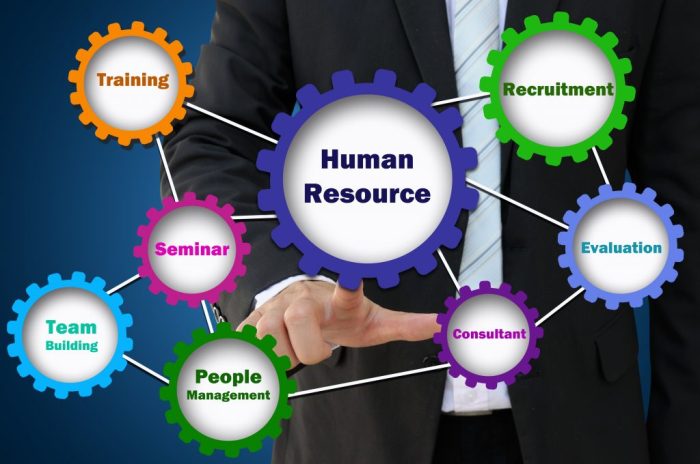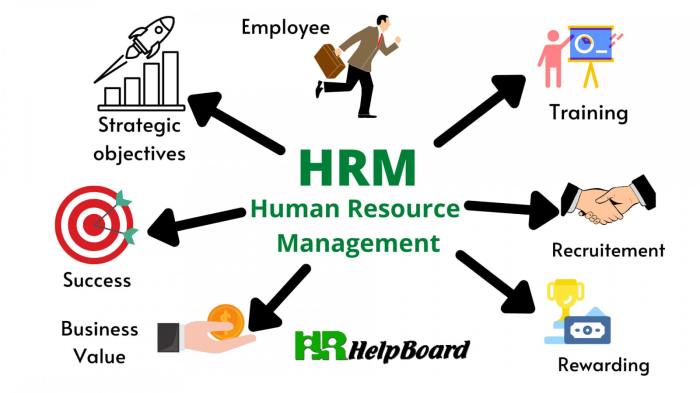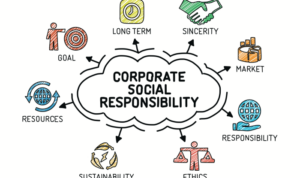Human resources management sets the stage for organizational success by overseeing key functions like recruitment, employee relations, and performance appraisal. Dive into the world of HR management with this engaging overview.
Definition of Human Resources Management
Human Resources Management refers to the strategic approach to managing people within an organization to maximize their performance and help achieve the company’s objectives. It involves recruiting, training, and developing employees, as well as handling employee relations and ensuring compliance with labor laws.
Importance of HR Management
- Ensures the right talent is hired for the right roles, leading to increased productivity and efficiency.
- Helps to create a positive work environment, fostering employee satisfaction and reducing turnover rates.
- Manages employee development and training programs to enhance skills and knowledge, contributing to overall company growth.
- Handles employee relations and conflict resolution, maintaining a harmonious workplace.
- Ensures compliance with labor laws and regulations, reducing legal risks for the organization.
Key Responsibilities within HR Management
- Recruitment and Selection: Attracting and hiring qualified candidates for open positions.
- Training and Development: Providing opportunities for employees to enhance their skills and grow within the organization.
- Performance Management: Evaluating and rewarding employee performance to drive motivation and productivity.
- Compensation and Benefits: Designing competitive salary and benefits packages to attract and retain top talent.
- Employee Relations: Handling conflicts, grievances, and ensuring a positive work environment for all employees.
Core Functions of Human Resources Management

Human Resources Management plays a crucial role in the success of an organization by focusing on various core functions that contribute to the overall well-being of employees and the company.
Recruitment and Selection Process
The recruitment and selection process in HR management involves identifying the staffing needs of the organization, sourcing potential candidates, screening applicants, conducting interviews, and ultimately hiring the most qualified individuals for the job.
Employee Development and Training
- Employee development and training are essential aspects of HR management that focus on enhancing the skills and knowledge of employees to improve performance and productivity.
- HR management designs training programs, workshops, and seminars to help employees learn new skills, adapt to changes in the workplace, and advance their careers.
- Employee development also includes performance evaluations, feedback sessions, and opportunities for growth within the organization.
Maintaining a Positive Work Environment
- HR management plays a vital role in creating and maintaining a positive work environment that fosters employee engagement, satisfaction, and overall well-being.
- By implementing effective communication strategies, conflict resolution techniques, and employee recognition programs, HR management helps to boost morale and promote a healthy organizational culture.
- Employee welfare initiatives, wellness programs, and work-life balance policies are also key components of maintaining a positive work environment.
Employee Relations and Conflict Resolution
Effective employee relations play a crucial role in HR management as they contribute to a positive work environment, increased employee morale, and overall productivity. By fostering strong relationships between employees and management, HR departments can help prevent conflicts and address any issues that may arise in the workplace.
Strategies for Managing Conflicts in the Workplace
When conflicts arise in the workplace, HR departments can implement various strategies to address and resolve them effectively. Some common strategies include:
- Encouraging open communication between employees
- Mediation and conflict resolution training for managers
- Establishing clear policies and procedures for conflict resolution
- Creating a positive work culture that values collaboration and teamwork
Employee Relations Programs Implemented by HR Departments
HR departments often implement employee relations programs to promote a positive work environment and strengthen relationships between employees and management. Some examples of employee relations programs include:
- Employee recognition programs to acknowledge and reward outstanding performance
- Employee assistance programs to provide support for personal or work-related issues
- Team-building activities to enhance collaboration and communication among employees
- Conflict resolution training for employees and managers to address issues proactively
Legal and Ethical Considerations in HR Management
When it comes to Human Resources Management, legal and ethical considerations play a crucial role in maintaining a fair and compliant workplace environment. HR managers must adhere to key legal requirements and ethical practices to ensure the well-being of employees and the organization as a whole.
Key Legal Considerations for HR Managers, Human resources management
- Compliance with labor laws and regulations such as minimum wage requirements, overtime pay, and workplace safety standards is essential for HR managers. Failure to comply can result in legal consequences and financial penalties.
- Adherence to anti-discrimination laws, such as Title VII of the Civil Rights Act, the Americans with Disabilities Act (ADA), and the Age Discrimination in Employment Act (ADEA), is crucial to prevent discrimination in the workplace based on protected characteristics.
- Ensuring proper documentation and record-keeping practices is necessary to protect the organization in case of legal disputes or audits.
Importance of Ethical Practices in HR Management
- Practicing ethical behavior in HR management fosters trust and credibility within the organization, leading to a positive work culture and employee morale.
- Ethical conduct helps HR managers make fair and unbiased decisions, promoting equity and diversity in the workplace.
- By upholding ethical standards, HR managers can build strong relationships with employees, stakeholders, and the community, enhancing the organization’s reputation.
Consequences of Non-Compliance with Labor Laws and Regulations
- Non-compliance with labor laws and regulations can result in legal actions, fines, and penalties imposed by government agencies, leading to financial losses for the organization.
- Violations of anti-discrimination laws can result in lawsuits, damage to the organization’s reputation, and loss of talented employees, affecting productivity and profitability.
- Failure to maintain proper documentation and records can hinder the organization’s ability to defend against legal claims, resulting in costly litigations and settlements.
Performance Management and Appraisal
Performance management and appraisal are crucial processes in HR that involve setting performance goals, evaluating employee performance, and providing feedback to improve productivity and overall effectiveness within an organization.
Setting Performance Goals
- HR management plays a key role in collaborating with employees to set clear and achievable performance goals.
- These goals should be specific, measurable, attainable, relevant, and time-bound (SMART) to ensure clarity and alignment with organizational objectives.
- Regular communication and feedback between HR and employees are essential to track progress and make necessary adjustments to goals.
Evaluating Employee Performance
- HR management conducts regular performance reviews to assess how well employees have met their goals and objectives.
- Performance appraisals may include self-assessments, peer reviews, and manager evaluations to provide a comprehensive view of employee performance.
- Feedback from appraisals helps identify strengths, areas for improvement, and opportunities for training and development.
Benefits of a Well-Structured Appraisal System
- A well-structured performance appraisal system promotes transparency and fairness in evaluating employee performance.
- It assists in identifying high-performing employees for recognition, rewards, and career advancement opportunities.
- Regular performance appraisals contribute to employee engagement, motivation, and retention by fostering a culture of continuous improvement and development.
Training and Development Programs

Training and development programs play a crucial role in human resources management by enhancing the skills and knowledge of employees, ultimately leading to improved performance and productivity within the organization.
Types of Training Programs
- On-the-Job Training: This type of training involves learning while performing actual tasks and duties in the workplace, which can include job shadowing, mentoring, and coaching.
- Skills Development Workshops: These workshops focus on enhancing specific skills such as communication, leadership, time management, and technical abilities through interactive sessions and hands-on activities.
- Online Learning Modules: HR departments often provide access to online courses and resources to allow employees to develop their skills at their own pace and convenience.
- Professional Development Seminars: These seminars cover a wide range of topics related to career advancement, industry trends, and personal growth to help employees stay competitive in their field.
Importance of Training Programs
Training programs are essential for employee growth and organizational success as they:
- Enhance Employee Skills: By providing opportunities for learning and development, employees can acquire new skills and knowledge that are relevant to their roles.
- Boost Employee Morale: Investing in training programs shows employees that the organization values their growth and development, leading to increased job satisfaction and motivation.
- Improve Performance: Well-trained employees are more competent in their roles, leading to higher productivity, efficiency, and overall performance within the organization.
- Reduce Turnover: Employees who receive adequate training and development are more likely to stay with the organization, reducing turnover rates and associated costs.
Diversity and Inclusion Initiatives
Promoting diversity and inclusion in the workplace is a crucial role of HR management. By fostering a diverse and inclusive environment, HR departments can help create a more innovative, productive, and engaged workforce.
Benefits of Diversity and Inclusion Initiatives
- Diverse perspectives lead to more creative problem-solving and innovation.
- Inclusive workplaces have higher employee morale and engagement levels.
- Enhanced reputation and attractiveness to top talent in the market.
- Reduction in turnover rates and increased retention of employees.
Examples of Successful Diversity and Inclusion Programs
- Employee Resource Groups (ERGs) that provide a platform for underrepresented groups to connect and share experiences.
- Mentorship programs that pair employees from diverse backgrounds with senior leaders for guidance and support.
- Unconscious Bias Training to raise awareness and mitigate biases that may affect decision-making processes.
- Diversity recruitment initiatives to attract a more diverse pool of candidates during the hiring process.
HR Technology and Data Analytics
Technology has revolutionized the way HR departments operate, streamlining processes and improving efficiency. Data analytics plays a crucial role in helping HR professionals make informed decisions based on insights gathered from employee data.
Impact of Technology on HR Management Practices
- Automation of repetitive tasks such as payroll processing and benefits administration
- Enhanced recruitment processes through applicant tracking systems and online job portals
- Improved communication with employees using collaboration tools and intranet platforms
Data Analytics in HR Decision-Making Processes
- Identifying trends and patterns in employee performance and engagement
- Forecasting future staffing needs based on turnover rates and succession planning
- Measuring the effectiveness of training programs and performance evaluations
Examples of HR Software and Tools
-
Human Resource Information System (HRIS):
Integrates HR functions like payroll, benefits, and attendance tracking
-
Performance Management Software:
Helps in setting goals, tracking progress, and conducting performance reviews
-
Recruitment Software:
Streamlines the hiring process by managing job postings and applicant data





